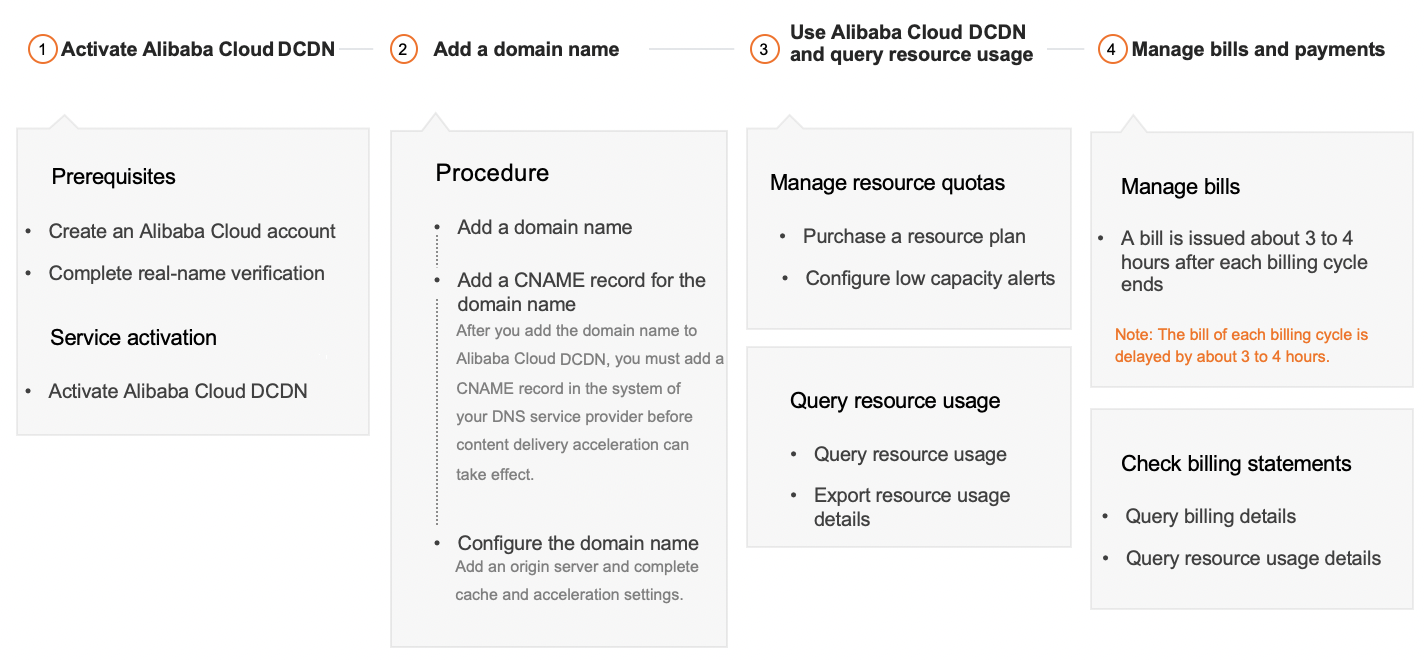This topic describes the billing methods, billable items, and pricing of Dynamic Content Delivery Network (DCDN).
Bills for DCDN are generated 3 to 4 hours after each billing cycle ends.
The following figure shows the procedure of using DCDN.
Billing methods
DCDN supports the pay-as-you-go billing method, which is the default billing method. You can also use resource plans to offset fees of commonly used resources.
Pay-as-you-go: You are charged for the actual usage of each billable item. Fees are deducted when resources are consumed. This billing method is ideal for scenarios in which you cannot accurately predict resource usage.
Resource plans (subscription): Resource plans use the subscription billing method, and provide savings on the costs of individual billable items. Resources are consumed before fees are offset by resource plans. Resource plans are ideal for scenarios in which you can accurately predict resource usage.
The subscription billing method is more cost-effective than the pay-as-you-go billing method.
If your resource usage exceeds the capacity of your plans, the overages are billed on a pay-as-you-go basis and are included in the bills. We recommend that you purchase resource plans based on the services that you need and the estimated amount of resource usage. For more information, see Guidelines for choosing resource plans.
Billable items
DCDN and IP Application Accelerator (IPA) are billed separately. If you use IPA, you are charged for the traffic that is accelerated by IPA. You are not charged for HTTP or HTTPS requests. For more information, see Billing of IPA.
DCDN generates bills for basic services and value-added services. If you select IPA, you are charged for IPA based on its billing schedule.
DCDN:
Basic services (required): You can choose between pay-by-data-transfer and pay-by-bandwidth. For more information, see Billing of basic services.
Value-added services (optional): You can enable one or more value-added services, such as HTTPS requests for static content and QUIC requests. For more information, see Billing of value-added services.
IPA: You can choose between pay-by-data-transfer and pay-by-bandwidth.
Billing cycle
The following table describes the billing cycle of DCDN.
Billing cycle | Bill release time | Billable item |
Hourly | You are charged on an hourly basis. A bill is generated about 3 to 4 hours after the end of a billing cycle. The time when bills are generated is determined by the system. |
|
Daily | You are charged on a daily basis. The bill of a day is generated and the amount due is deducted at around 04:00 on the following day. The time when bills are generated is determined by the system. |
|
Billable regions
The data transfer fee is calculated based on the unit price for the billable region where the data transfer is generated. DCDN has deployed sufficient redundant points of presence (POPs) in each billable region to ensure that each POP belongs only to one billable region.
Billable regions are listed in the following table. For more information, see POP distribution.
Billable region | Abbreviation | Region/Country |
Chinese mainland | CN | Regions in the Chinese mainland are in the same billable region. |
North America | NA | United States |
Europe | EU | Ukraine, UK, France, Netherlands, Italy, Sweden, Germany, and Spain |
Asia Pacific 1 | AP1 | Hong Kong (China), Japan, Singapore, Thailand, Philippines, and Malaysia |
Asia Pacific 2 | AP2 | Indonesia, India , Republic of Korea, and Pakistan |
Asia Pacific 3 | AP3 | Australia |
Middle East and Africa | MEAA | Türkiye, UAE, Kuwait, Qatar, Oman, Nigeria, and South Africa |
South America | SA | Brazil |
DCDN pricing
For more information about the pricing of each billable item, visit the DCDN pricing page.
For more information about the pricing of resource plans, see Resource plan pricing.
Outbound data transfer plans
We recommend that you choose resource plans based on the features and services that you want to use, and your business volume. For more information, see Overview, Guidelines for choosing resource plans, and Resource plan rules.
Alibaba Cloud DCDN outbound data transfer plans are applied only when the pay-by-data-transfer metering method is used. Otherwise, the data transfer plans are suspended until you switch back to the pay-by-data-transfer metering method. For information about how to change the metering method, see Change the metering method.
References
Billable items and billing methods | |
Resource plans | |
More |